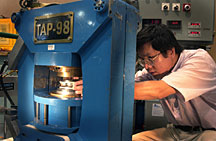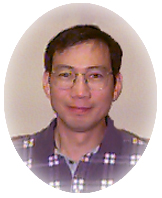Research
Highlights...
|
 |
| Number 170 |
November 1, 2004 |
|
DZero measurement another step in Higgs search
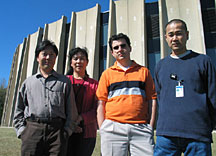 |
(Left to Right) Su Yong Choi (UC Riverside), Qizhong Li (Fermilab), Yildirim Mutaf (SUNY Stony Brook) and Kazu Hanagaki (Fermilab) have all worked on this analysis. |
The DZero experiment at DOE’s Fermilab has made the first measurement of Z+b production in a hadron collider environment, an important first step in looking for the Higgs in this channel. The Higgs boson is the last particle yet to be discovered in the Standard Model. It arises from the Higgs field that is thought to permeate the universe and give mass to all other particles. The Tevatron can search for a Higgs produced in association with a Z boson, and observing Z+b production and measuring its rate are crucial. The measurement was done at the Tevatron by comparing the number of events with Z+b to the number of events with a Z and other quarks.
[Davide Castelvecchi, 630-840-3351;
castel@fnal.gov]
|
|
Antennas go to the head of the class at INEEL
Wireless hotspots are cropping up nearly everywhere—even entire towns are blanketing their neighborhoods with Internet access. But enveloping large swaths of land with umbrella coverage isn't always ideal. Designers may prefer access points to hand out the equivalent of personal raincoats—providing coverage that follows individual users while leaving hackers out in the storm. Engineers at DOE's Idaho National Engineering and Environmental Laboratory are working to do just that, by combining several antenna elements into one "smart antenna" system. Their work will help wireless networks reach farther, juggle more users, navigate tricky environments, avoid electronic interference, and block rogue users.
[Regina Nuzzo, 208/526-3176;
nuzzrl@inel.gov]
|
|
Exploring the history of water on Mars
A team of researchers at DOE's Los Alamos National Laboratory has devised an analytic method for determining whether sulfate salts can account for evidence of water on Mars. The team exposed magnesium sulfate salts to various temperature, pressure and humidity conditions in the laboratory in order to correlate salt hydration states with martian surface conditions. The researchers discovered that the crystalline structure and water content of the salts are dependent on time-humidity history. Researchers theorize that magnesium salts could retain sufficient water to explain at least some of the NASA Odyssey observations, which revealed surprisingly high abundances of near-surface hydrogen on Mars.
[Todd A. Hanson, 505/665-2085;
tahanson@lanl.gov]
|
|
Snapshot yields inside look at molecular movement
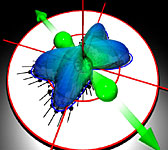 |
Clearest snapshot yet of the simultaneous behavior of all the electrons and nuclei inside a molecule. |
The secret lives of molecules are now less secret. Using the Advanced Light Source at DOE's Lawrence Berkeley National Laboratory, an international team of physicists has obtained the clearest snapshot yet of the simultaneous behavior of all the electrons and nuclei inside a molecule. Their work, in which they broke apart a deuterium molecule and measured the momenta of its particles, opens the door for a more basic understanding of molecules and the everyday processes they drive, from breathing to rust to photosynthesis. “Nothing stands still. By learning how particles move, we can probe the fundamental properties of molecules and how they work,” says Thorsten Weber, a visiting scientist in Berkeley Lab’s Chemical Sciences Division who conducted the research with several other Berkeley Lab scientists, as well as physicists from Kansas State University and institutions in Australia, Germany, and Spain. Their research is published in the Sept. 24 issue of Nature. [Dan Krotz, 510/486-4019;
dakrotz@lbl.gov]
|
|
Peering inside the body, with a new spin—literally
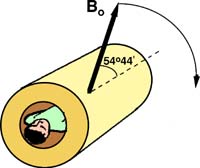 |
Slow MAS inventor Robert Wind believes the new technology can be applied to diagnosis of cancer and other diseases and used to see if drugs are working in the body as intended. |
A technique patented by DOE's Pacific Northwest National Laboratory called slow magic-angle spinning magnetic resonance spectroscopy, or “slow MAS,” is providing researchers a new glimpse inside living tissue and cells. Slow MAS, where a biological sample or live animal is rotated at a precise angle to a strong magnetic field, is a noninvasive way to derive a chemical spectrum that shows function of living organs, fat, glucose and other metabolites at unprecedented resolution. PNNL is refining the technique, which researchers believe can be used to diagnose diseases, assess the body's response to drugs, and even to observe the working physiology of living cells.
[Bill Cannon, 509/375-3732;
cannon@pnl.gov]
|
|
|
SLAC's Chen gets a cosmic charge
Pisin Chen knows that accelerators are astronomically useful, and he’s not exaggerating: He uses the powerful linear accelerator at DOE's Stanford Linear Accelerator Center to study astrophysics and cosmology in a controlled laboratory setting.
SLAC physicist Chen began his career as a theoretical particle physicist with training from the University of California, Los Angeles. He developed original theories about using plasma for particle acceleration and for focusing particle beams, and has made seminal contributions to the physics of beamstrahlung in linear colliders.
Chen migrated to astrophysics and cosmology in the 1990s, when he heard results from the satellite experiment COBE that detected fluctuations in the cosmic microwave background that permeates the universe.
“When I saw that by putting detectors into space our eyesight, so to speak, became instantly clear, without pollution or atmospheric fluctuations, I quickly recognized astrophysics would enjoy a new renaissance and I immediately switched myself into it,” he said.
Chen won an international Gravity Research Foundation Prize in 1995 for theoretical work showing additional ways that fluctuations in the cosmic microwave background could occur. He helped found the joint SLAC and Stanford University Kavli Institute for Particle Astrophysics and Cosmology. He leads a SLAC group that does both theoretical and experimental research in this frontier area.
His current experiment, FLASH, attempts to shed light on a crucial discrepancy between two world-leading experiments measuring ultra high energy cosmic rays (UHECRs). As they scream through our atmosphere, UHECRs turn into showers of charged particles that trigger nitrogen atoms in the air to fluoresce. FLASH measured precisely how much fluorescence is generated for each high-energy electron passing through simulated atmospheres in the lab. The experiment also simulated cosmic ray showers in the lab to monitor their development corresponding to different heights in the atmosphere. The results are important for current and future space-based and ground-based UHECR experiments.
Submitted by DOE's
Stanford Linear Accelerator Center
|
|
